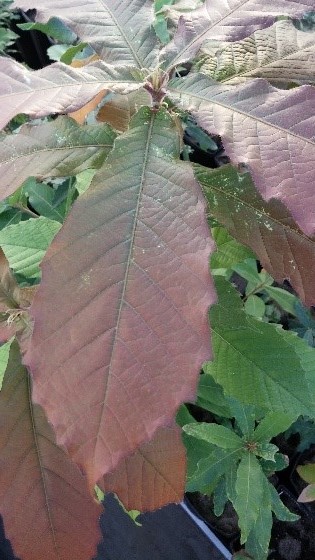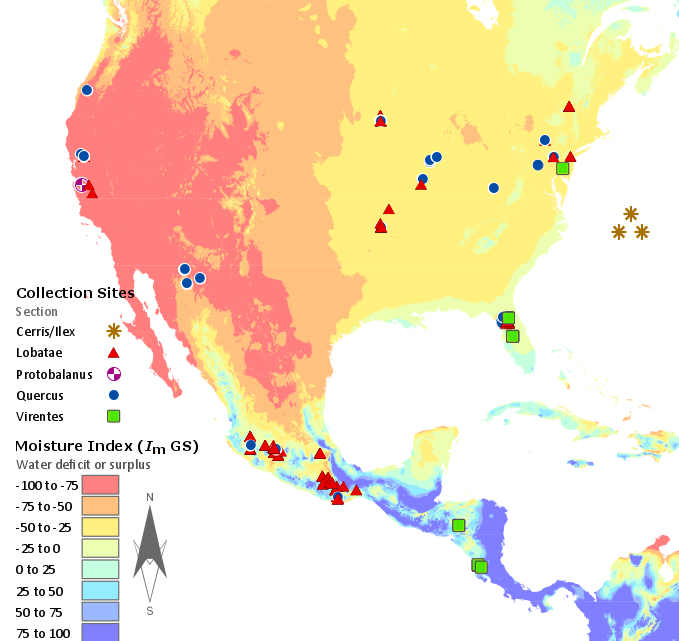Dr. Kaproth's Research Projects
 The Kaproth Lab investigates how plant species adapt and spread across environments.
The Kaproth Lab investigates how plant species adapt and spread across environments.
We tend to focus on oaks as a model system - which are the most diverse and abundant woody genera in the United States and Mexico. Past work shows these North American species diversified from a common ancestor and converged on drought adaptataion patterns.
Plant systems allow us to investigate fundamental ecological processes driving species success and providing practical applications for species management. I am especially interested in focusing on plant drought tolerance, functional trait adaptation, the interaction of soil and plants, as well as invasive species biology. My lab uses common gardens, herbarium collections, Geographical Information Systems (GIS), along with lab and field measurements to investigate the evolution of stress tolerance (and suites of additional traits) across the Americas.
The Kaproth Lab works with a team of collaborators. We have conducted systematics and demographic studies in widespread plant systems (oaks and maples), rare plant systems (prairie) and invasive plant systems (such as reed canarygrass, Phalaris arundinacea and tree-of-heaven, Ailanthus altissima).
Areas of interest:
- Botany / Ecology / Ecophysiology
- Systematics / Trait variation and adaptation / Drought tolerance
- Invasive species
- Plant conservation / Prairies & Savanna
- Population biology & dispersal
- Environmental science
- Remote sensing & GIS
- Environmental policy
Lab MEMBERS aND CURRENT PROJECTS
Recruitment:
For Fall 2027, I may be looking for an *exceptional* MS graduate student to work on biology research related to sugar maples, oaks and/or prairie systems. Students must be *highly motivated* and have a strong interest in plant ecology (projects should include investigations in drought tolerance, ecophysiology, and systematics with a focus on GIS, statistics, analysis, and ecosystem health) using lab and field work. The student may work with a team of collaborators to look at systems across the Americas.
The research may be conducted at local field sites (e.g. in Minnesota) but may have fieldwork outside of the state. The academic portion of the degree will take place at Minnesota State University, Mankato. To conduct research, you may need to coordinate undergraduate student assistants, be able to drive, and/or work in adverse (hot) conditions.
Caveat: I don’t expect you to know exactly what project you want to research, but you should be driven to investigate ecological or plant fitness and production questions.
If interested in joining the lab for a MS DEGREE, please email me the following:
- A letter of interest that tells me about your research interests, background, types of questions you are interested in, etc.;
- An unofficial university transcript (your undergraduate GPA should be >3.0);
- Outstanding communication and writing skills;
- Your CV (including the contact information for a reference);
- Anything else that you think makes you uniquely qualified for the position
Here’s a part of what I can contribute:
- Attentive mentorship and career development;
- Training in statistics, plant biology/ecology, ecophysiology, plant systematics, and experimental design;
- Teaching opportunities (Teach Assistantship with $10k stipend and tuition waiver);
- Additional summer support (Research Assistantship if herbarium-based work);
- Contacts in academia and with regional partners (Montana State University, Michigan State University, University of Minnesota, MN Dept. of Natural Resources, The Prairie Enthusiasts, Morton Arboretum, etc.)
- An ally and an environment that encourages a healthy work-life balance (i.e. gentle reminders of ways to thrive as a grad student)


